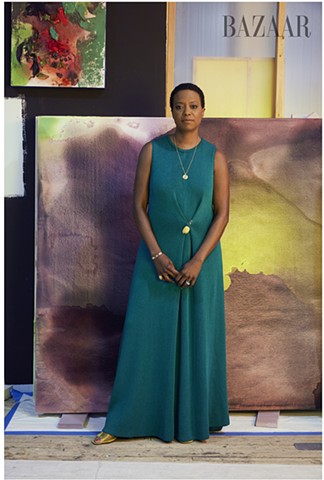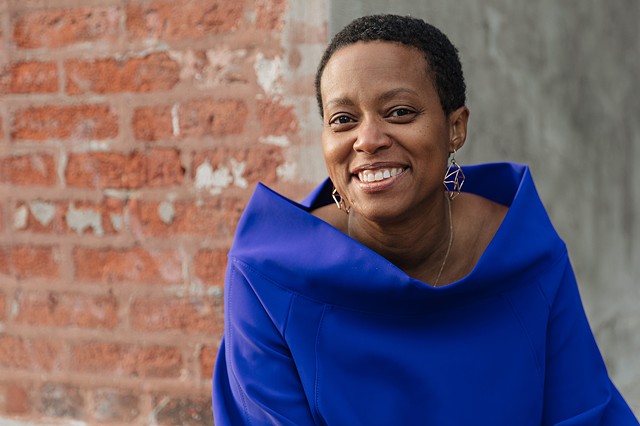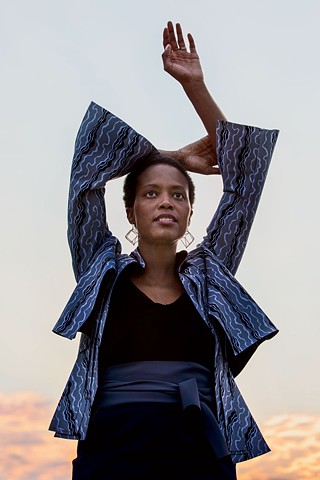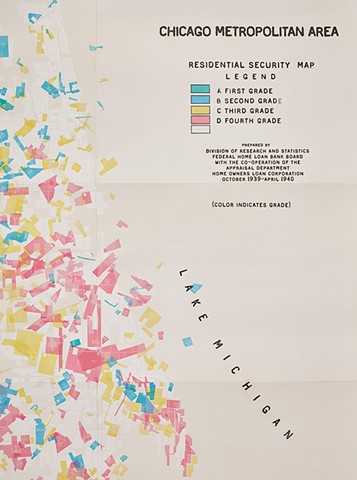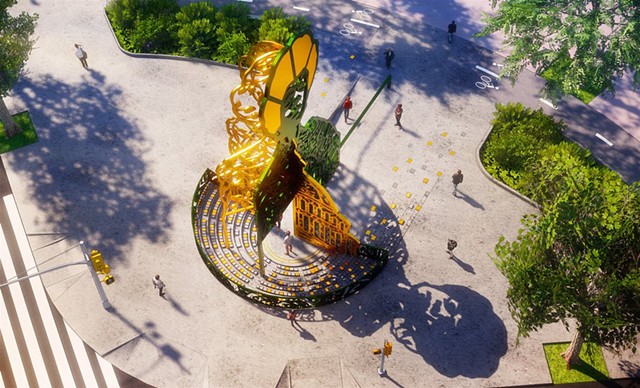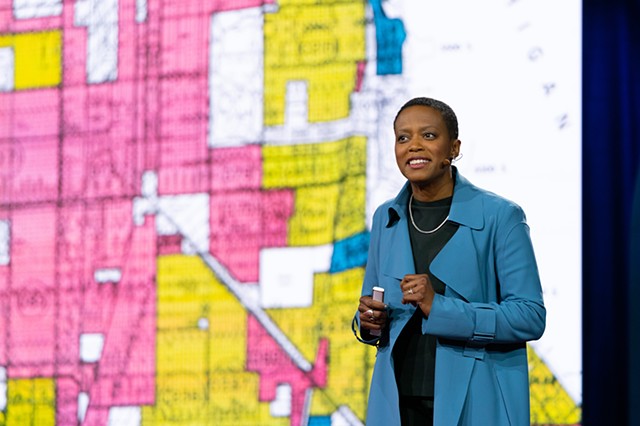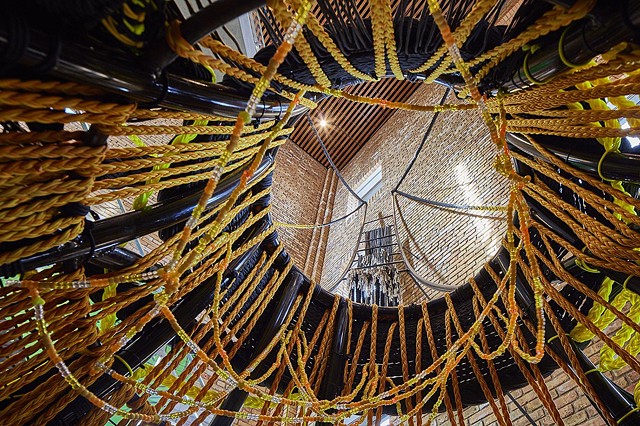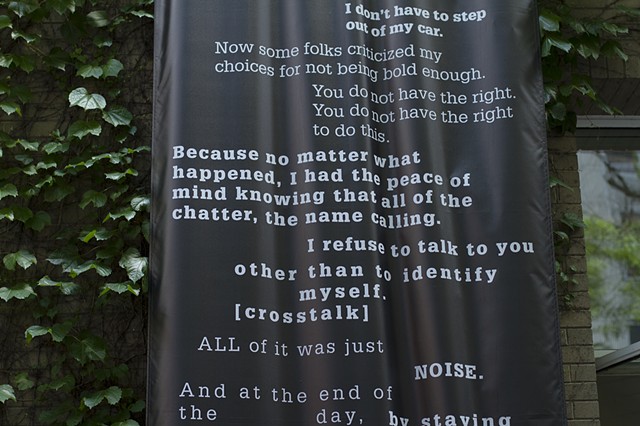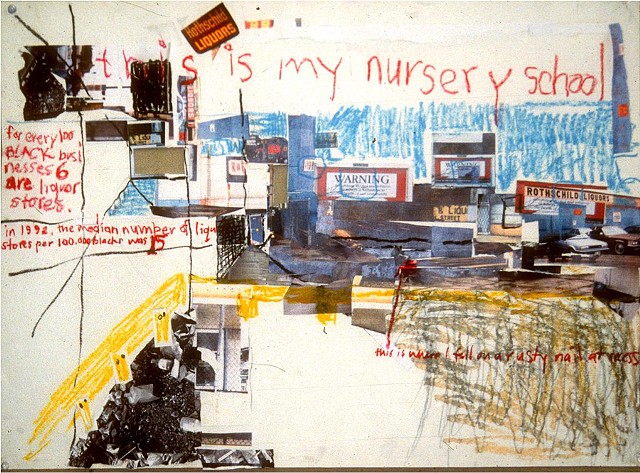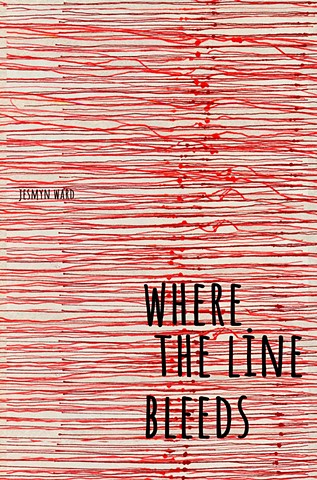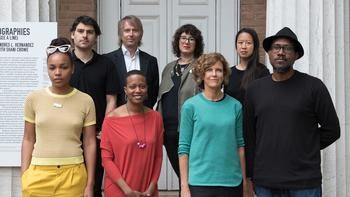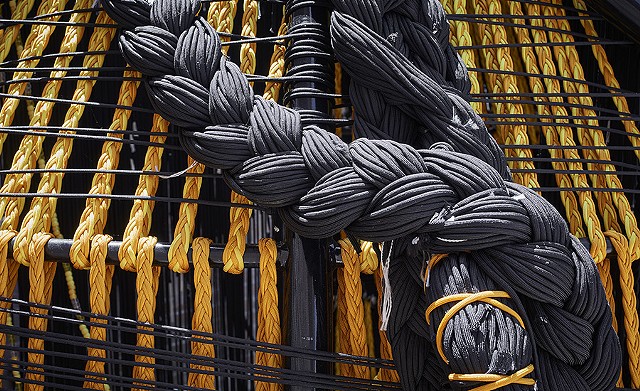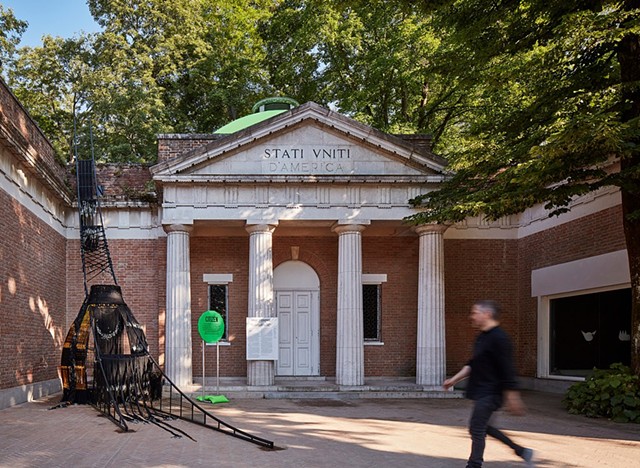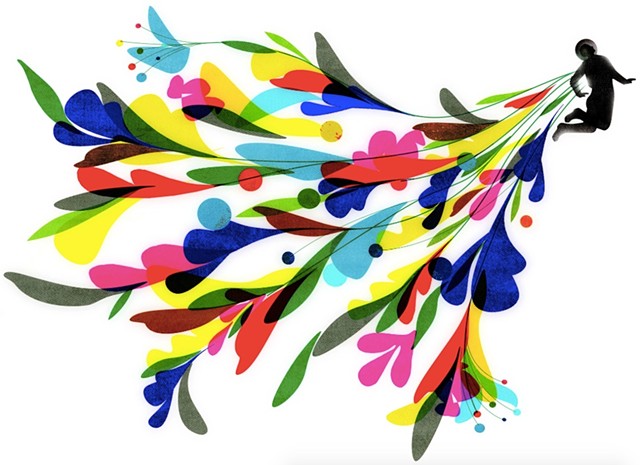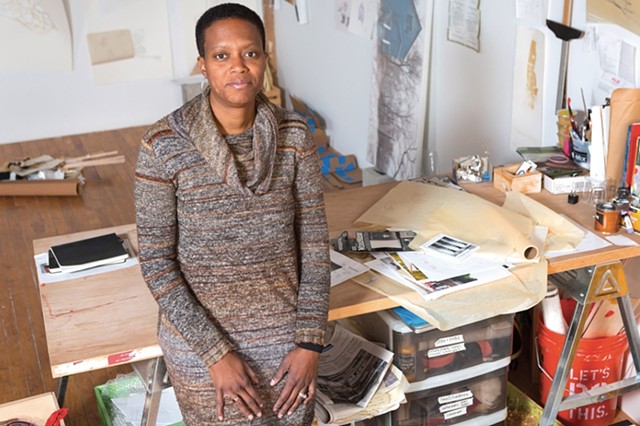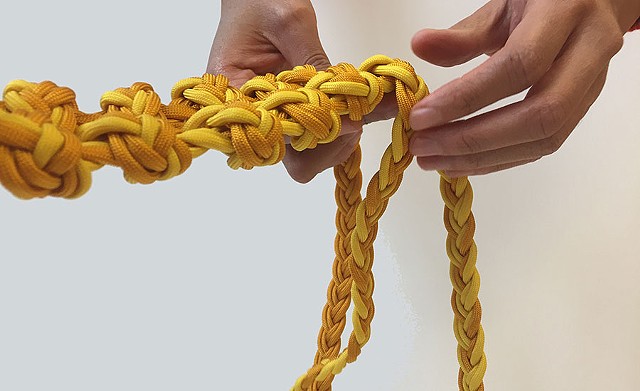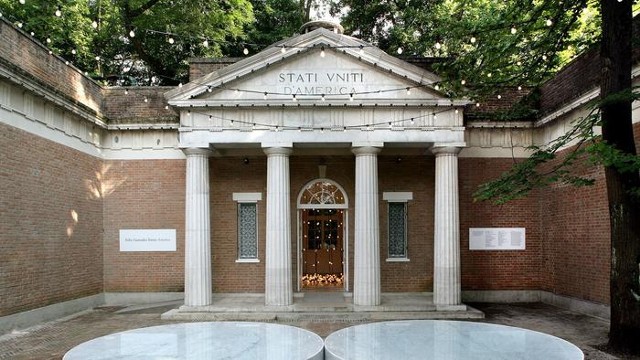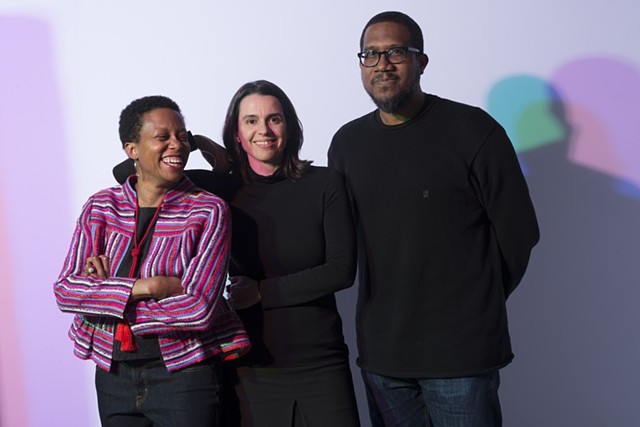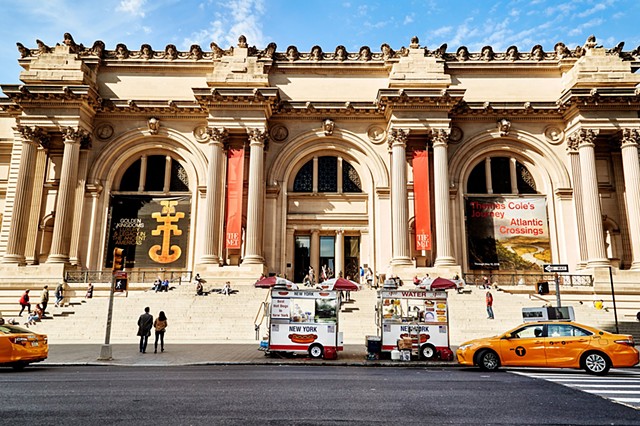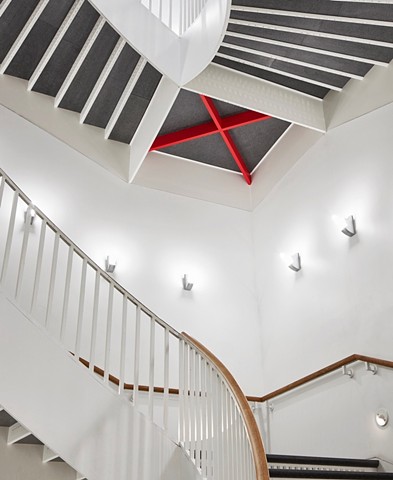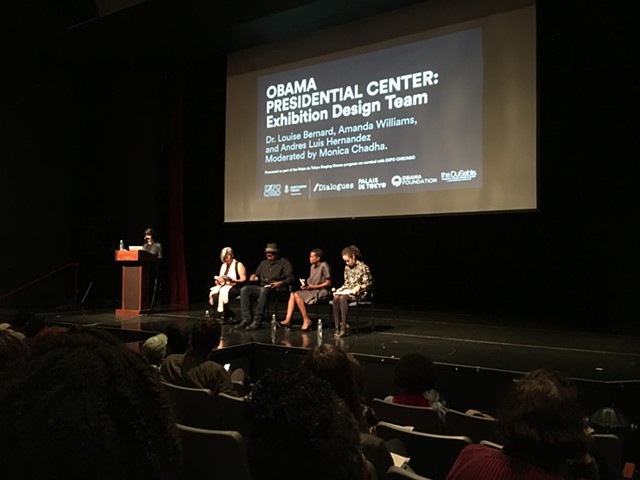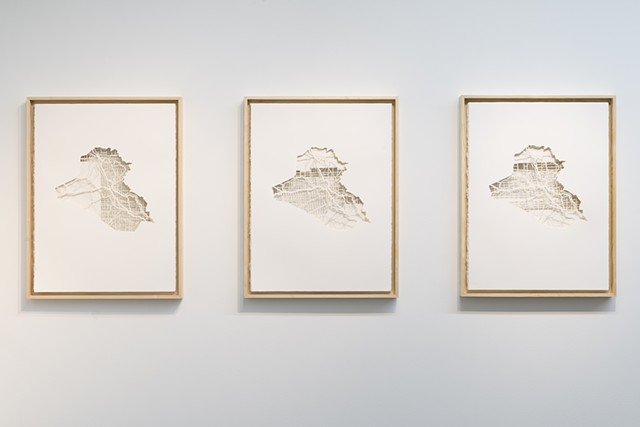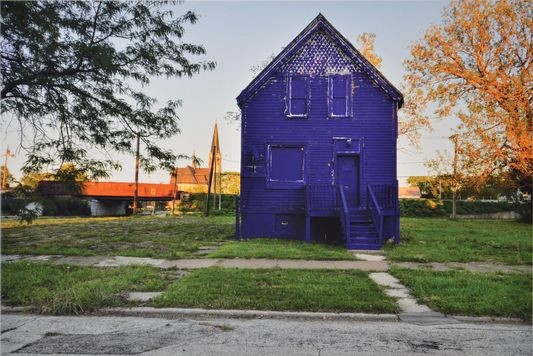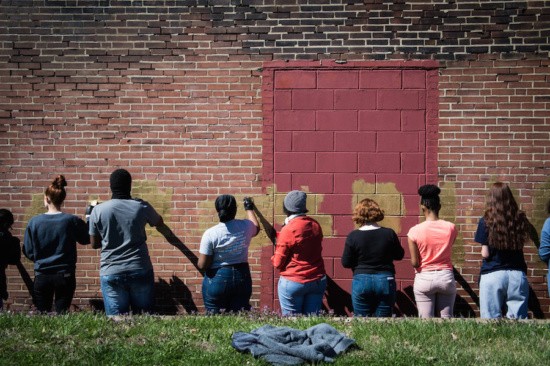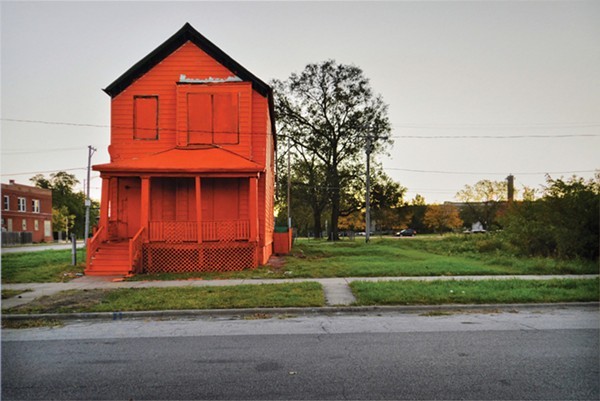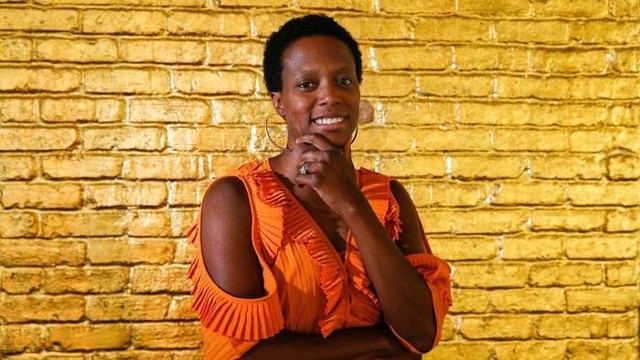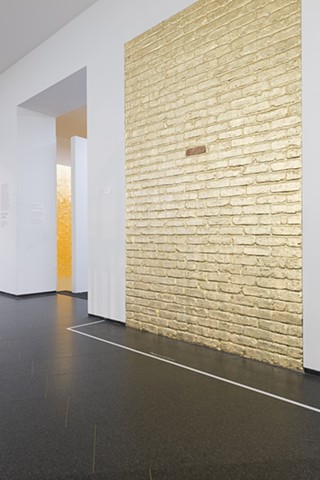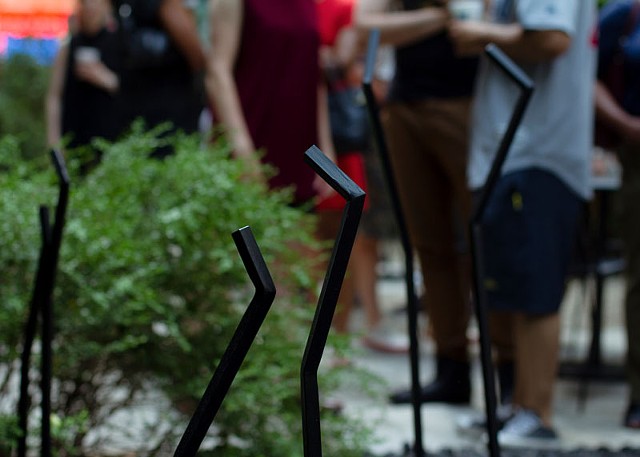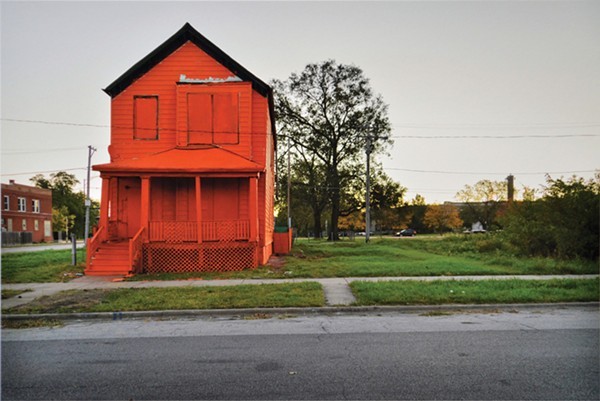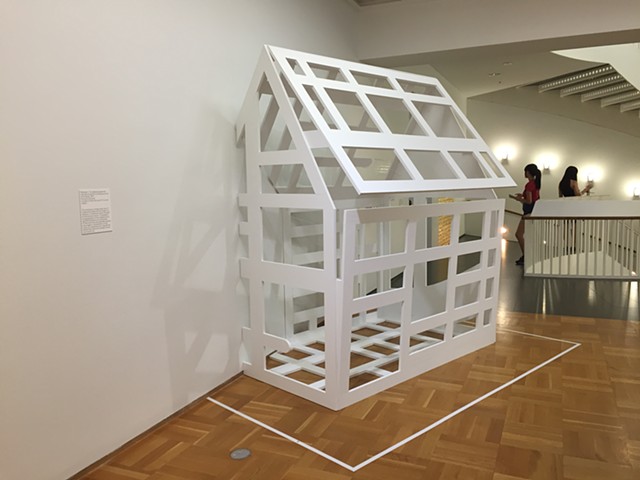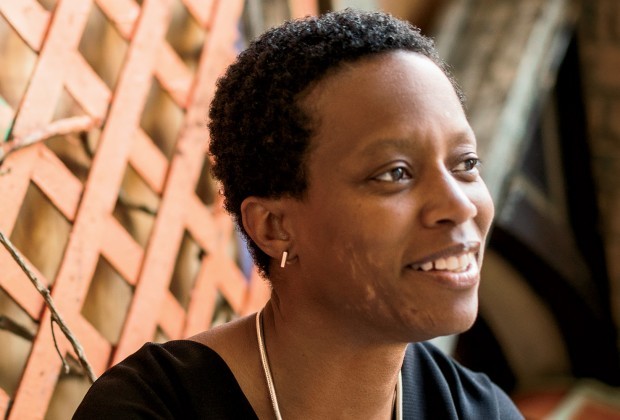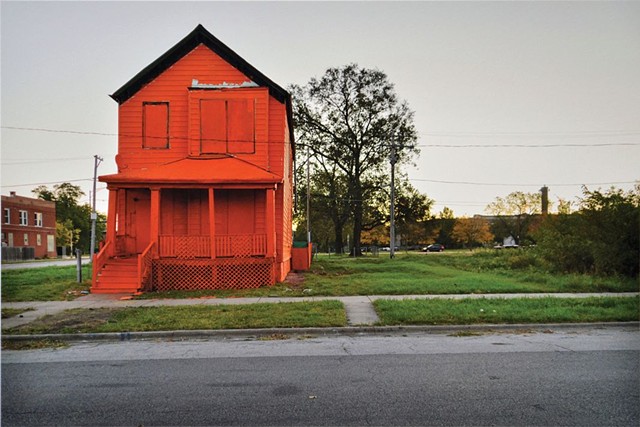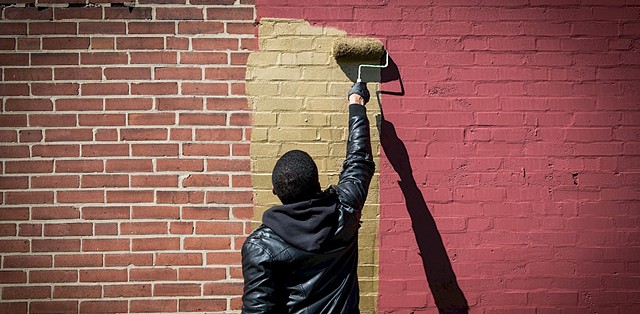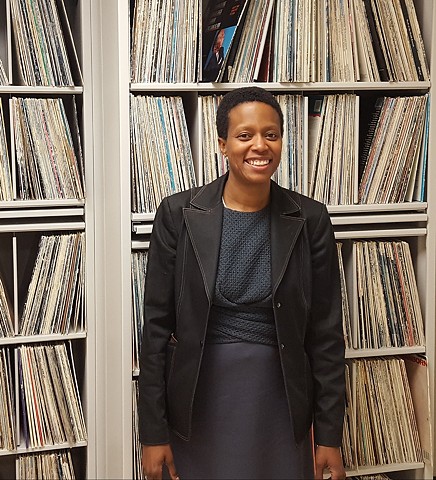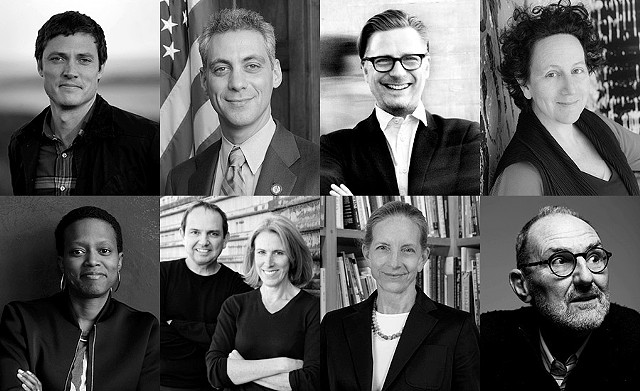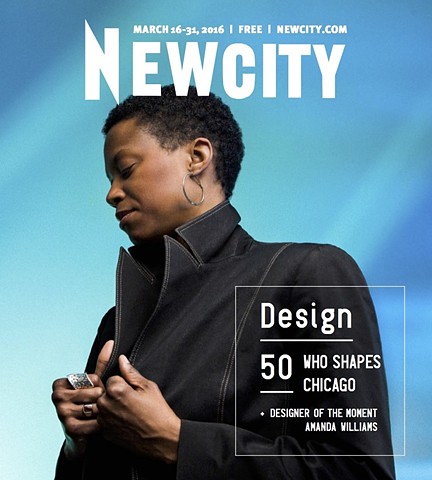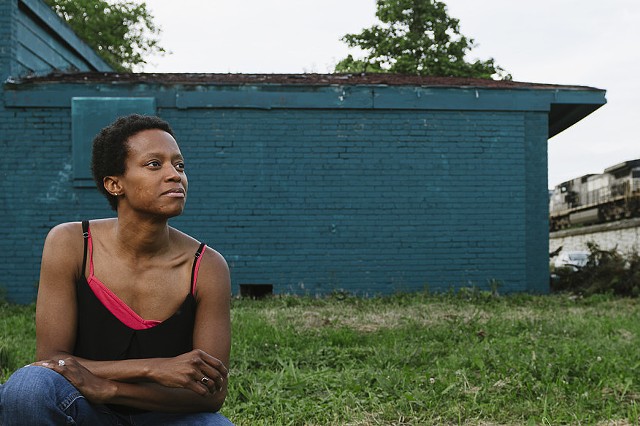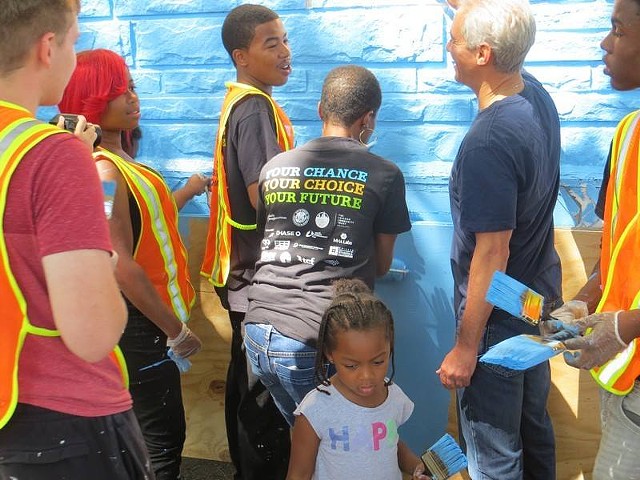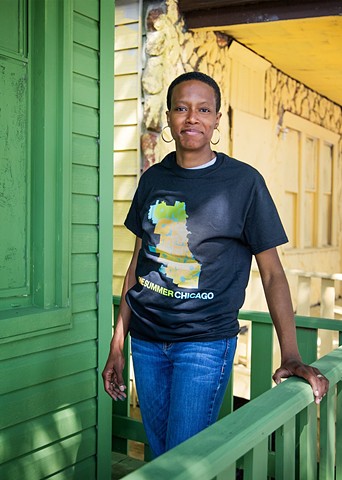How Chicago Became an Art-World Capital Without Giving In to Art-World Clichés
How Chicago Became an Art-World Capital Without Giving In to Art-World Clichés
December 2022
Harper's Bazaar
by Stephen Mooallem/Photographs by John Edmonds/Styling by Alexandra Delifer(excerpt)
Chicago was home to a mid-20th-century literary renaissance; an incubator for blues, jazz, and house music; the land of Archibald Motley and Richard Wright, of Lorraine Hansberry and Gwendolyn Brooks. It was the birthplace of modern sociology and advertising, a locus of the Great Migration. It is a city that was razed by a fire and rebuilt as a forest of skyscrapers. It is also one that has been shaped by decades of segregation and systemic racism, which were not just the results of public policy, urban planning, and discriminatory real estate practices but the very aim of them. As Mies van der Rohes rose in Lakeview and Lincoln Park, neighborhoods on the South and West Sides were decimated by poverty, crumbling infrastructure, school closures, violence, and the exploitation and willful neglect of developers and public officials. Read More HereAmanda Williams named a 2022 MacArthur Fellow
(excerpt)
Amanda Williams named a 2022 MacArthur Fellow
October 12, 2022
Amanda Williams is an artist who uses ideas around color and architecture to explore the intersection of race and the built environment. Her works visualize the ways urban planning, zoning, development, and disinvestment impact the lives of everyday residents, particularly in African American communities.Williams’s series Color(ed) Theory (2014–2015) exemplifies an artmaking practice that is both personal and responsive to the current moment. Williams, along with family and friends, covertly painted empty houses slated for demolition in Chicago’s Englewood neighborhood. They painted each structure in one vibrant color with cultural associations immediately apparent to the neighborhood's predominantly Black residents: Harold’s Chicken Shack red, Ultrasheen conditioner blue, Safe Passage yellow. In so doing, Williams created bold visualizations of community life in the neighborhood, despite the neglect and disinvestment that contributed to the structures’ deterioration. The series also poses questions about how economic, cultural, and aesthetic value of an object or community is determined. Williams’s investigation of color continued in a project she initiated in 2020 entitled What black is this you say? It began as a series of Instagram posts of different hues of black accompanied by text that humorously comments on the variedness of Black culture. The project evolved to include paintings and a public installation. Taken together, the works in this series challenge notions of a uniform Blackness. [continue here]
The New York Times - How Can Blackness Construct America?
How Can Blackness Construct America?
March 11, 2021
The New York Times
By Michael Kimmelman(excerpt)
What’s below is a conversation with members of the Black Reconstruction Collective, which came together during the past year and a half, in tandem with an exhibition now at the Museum of Modern Art called “Reconstructions: Architecture and Blackness in America.” The collective’s members are the 10 architects, artists and designers in the exhibition.The show includes some mind-bending, beautiful work, on view through the end of May. But the collective emerged to serve longer-term, more radical goals.
It taps into a legacy of Black collectives from earlier eras. In 1893, Ida B. Wells and Frederick Douglass joined to publish “The Reason Why the Colored American Is Not in the World’s Columbian Exposition.” Seven years later, W.E.B. Du Bois, Booker T. Washington and Thomas J. Calloway organized a display of charts and photographs about the African-American experience to counter depictions of Black Americans at the world’s fair in Paris.
These were necessary responses to a system of cultural exclusion that, time and again, erased, demeaned and denied Blackness. By the 1960s, in the wake of the Black Power movement, a variety of Black artists’ collectives had coalesced, among them Spiral, which included Norman Lewis and Romare Bearden; Amiri Baraka’s Black Arts Movement; and AfriCobra, a Chicago-based Black artists’ commune.
“We have a responsibility beyond the exhibition, beyond us,” is how Amanda Williams, a Chicago-based architect and artist, and one of the members of the Black Reconstruction Collective, summed up the group’s thinking.
The Chicago Tribune - Chicagoan of the Year Visual Artist
Amanda Williams gave us tastes and glimpses of ‘Blackness,’ artistic proof that the culture is not monolithic. If you don’t know, now you know.
December 22, 2020
Chicago Tribune
By Darcel Rockett(excerpt)
How much do you think about color? The hues that exist around you? Some may affect your mood? While other shades carry with it a historical meaning and begs for proper context.For Amanda Williams, color is a constant in her work. In this pandemic year, Williams looked at Blackness in its myriad colors. Her series called “What Black is This, You Say?” is one focused on various photos of black items posted on her Instagram account. The viewer can see the tint, but can’t necessarily make out the actual item in the picture. The images are accompanied by text/caption that describes the pigmentation at which you are looking. The wording can be funny, introspective, flip, or right on the nose. The series follows her previous multiyear “Color(ed) Theory” project wherein she painted condemned South Side houses in colors like Harold’s Chicken Shack red, Newport 100s teal, and Crown Royal bag purple to acknowledge the racially tinted architectonic blight of Black communities.
Momentum - What Black Is This?
What Black is This?
December 10, 2020
Momentum
By Adrienne Sammuels Gibbs(excerpt)
The Instagram post started with a question.“What black is this you say?”
“‘Apparently even Aunt Jemima and Uncle Ben’s Lives Matter now’–black’”
The inquiry, and the answers, became part of an art installation that celebrates Black culture and identity while also highlighting the moments of 2020 that America will not soon forget. Chicago-based artist Amanda Williams kicked off the multiplatform series in June 2020, not long after George Floyd’s death. She would post an inky image; sometimes with form, sometimes without, and then type in her ask. The answer always merged color with culture.
WTTW - Chicago Artist Explores Blackness as Both a Color and Identity in New Exhibit
Chicago Artist Explores Blackness as Both a Color and Identity in New Exhibit
November 17, 2020
WTTW News
Angel Idowu(excerpt) For the first time ever, the arts nonprofit 3Arts is gifting a trio of past grant recipients with a second award — this time, for $50,000.
Among those recipients is Chicago-based artist and architect Amanda Williams, whose latest exhibition responds to the social media trend Blackout Tuesday, in which Instagram users posted black squares to show solidarity with the Black Lives Matter movement.
“In a city like Chicago and growing up black on the South Side, you cannot ever be separated from your race,” Williams said.
For the past six months, she has been identifying a different “black” every day on Instagram. It has since turned into the exhibit, “What black is this you say?”
The New York Times - Seeing Black Futures
Seeing Black Futures
October 7, 2020
The New York Times
By Jenna Wortham and Kimberly Drew(excerpt) In a piece titled “LTS I,” the Nigerian-American artist Toyin Ojih Odutola paints her brother in repose, with midnight-colored skin, gold jewelry and piercing eyes, unconcerned by who might be looking at him. The painting is part of “Like the Sea,” a series of portraits of her two younger brothers rendered in her signature style, which emphasizes the depths of Black skin by applying layers of color, in this case, black pastels. Ojih Odutola said she gave her subjects the range to “just be” and exist “as they are,” rather than forcing them into backdrops that might have felt more recognizable, or informed by historical representations of Black people.
Chicago Magazine - See Amanda Williams’s Momentous Solo Art Exhibit
Photograph: Alexus McLane
See Amanda Williams’s Momentous Solo Art Exhibit
September 22, 2020
Chicago Magazine
By Kerry Cardoza(excerpt) If you were looking at your Instagram feed on June 2, you likely saw a procession of black squares in place of pictures. The “blackout” was a global act of social media protest in response to the police killings of George Floyd, Breonna Taylor, and Ahmaud Arbery. On that same day, local artist Amanda Williams uploaded a different kind of black square, not stark black but a lighter shade, strewn with blurred strands of gray. She wrote an extended caption underneath that read, in part, “You can’t just say ‘black’ ... which one?” Each day afterward, she would post a variation of black with a riff on the motif “What Black is this you say?” On June 2, it was “Your mother’s Andriana fur mink coat black her name embroidered in gold cursive on the inside.”
Chicago Tribune - Amanda Williams’ latest multi-platform project ‘What Black Is This, You Say?’ examines Blackness in its multitude of variations
Amanda Williams’ latest multi-platform project ‘What Black Is This, You Say?’ examines Blackness in its multitude of variations
August 13, 2020
Chicago Tribune
By Darcel Rockett(excerpt) Blackout Tuesday, June 2, was over two months ago — the collective response, an action to racism and police brutality following the killings of George Floyd , Ahmaud Arbery, and Breonna Taylor. Artist Amanda Williams — known for her “Color(ed) Theory” project wherein she painted condemned South Side houses in colors like Harold’s Chicken Shack red, Newport 100s teal, and Crown Royal bag purple to acknowledge the racially tinted architectonic blight of black communities — got swept up in the moment, the day when millions of social media users posted a black square, alongside the hashtag #blackouttuesday to show solidarity with the #blacklivesmatter pairs.
According to a post on Williams’ Instagram page, she hates stuff like that — stuff being the overwhelming “sense of urgency” people have to have (a resolute answer or a finite way) that they can understand very complex things that have been going on a long time.
MORE HEREIIDA - Experience: Art, Culture, Design
Join moderator IIDA Executive Vice President and CEO Cheryl S. Durst, Hon. FIIDA, and participants Amanda Williams, renowned Chicago-based artist and architect, and Madeleine Grynsztejn, Pritzker Director of the Museum of Contemporary Art Chicago, for an enthralling discussion on art in the time of COVID; how museums, galleries, and DIY spaces will continue to adapt for the future; and the ways we can let society know that creativity can’t be canceled.
Architectural Record - Do the Work: Amanda Williams on the Road to Justice
Do the Work: Amanda Williams on the Road to Justice
June 12, 2020
Architectural Record
By Kara Mavros(excerpt) From artist Amanda Williams’ perspective, the brutality experienced by Black people at the hands of the police is nothing new. To her, it’s “just another day, just like it’s been for the last 45 years of my life.” What does feel new now, however, is the widespread outrage and protest that George Floyd’s killing—and other acts of police violence—have prompted around the world. “All of a sudden it’s become urgent for everyone else. That seems very strange and foreign, and kind of like a dream.” Williams, who earned her B. Arch. from the Cornell University School of Architecture, Art, and Planning (AAP), deals with the complexities of race, place, and value in her work, which has been featured in the U.S. Pavilion of the 2018 Venice Architecture Biennale, the Museum of Contemporary Art in Chicago, and the 2016 Chicago Architecture Biennial. The realities of systemic racism that much of the world has just awoken to are the constants in both her art and daily life.
MORE HERECalls for Change: On Race and Racism in Practice and Pedagogy, Policy and Design
Calls for Change: On Race and Racism in Practice and Pedagogy, Policy and Design
June 6, 2020
Cornell AAP Architecture Art Planning
By Patti Witten(excerpt) In the days following the murder of George Floyd in Minneapolis on May 25, and in the midst of the COVID-19 pandemic, institutions, governments, businesses, and individuals have added their voices and intentions to the eruption of protests and the forces behind them.
Both in the media and in the streets, a challenge to all is that the long history of racial injustice and anti-black violence and demands for change must be grappled with in the complex context of our time — and to see the convergence of voices and actions from people who bring different perspectives and resources to the table.
MORE HEREAnnouncing Arts for Illinois and the Arts for Illinois Relief Fund
A collaboration between the City of Chicago, the State of Illinois, private philanthropy and YOU to support the arts community during the COVID-19 crisis.
Artnet - Lori Lightfoot’s First Order of Business as the New Mayor of Chicago? Borrowing This Artwork About the History of Redlining for Her Office
Detail shown above of Amanda Williams’s Cadastral Shaking (Chicago v1) (2019) is currently on loan to newly inaugurated Chicago Mayor Lori Lightfoot. Photo courtesy of Tom Harris Photography.READ IT:
Lori Lightfoot’s First Order of Business as the New Mayor of Chicago? Borrowing This Artwork About the History of Redlining for Her Office
May 21, 2019
Artnet
By Sarah Cascone(excerpt) After Lori Lightfoot was sworn in yesterday as the 56th mayor of Chicago, officially becoming the first African American woman and the first openly LGBTQ person to hold the office, she unveiled her newly decorated office with a last-minute loan from the Smart Museum of Art on the South Side of the city.
Less than 24 hours earlier, the work, commissioned by the museum from artist Amanda Williams, was still at the museum as part of an exhibition titled “Solidary & Solitary” featuring works by African American artists from the collection of Pamela J. Joyner and Alfred J. Giuffrida.
MORE HEREThe New York Times - The Shirley Chisholm Monument in Brooklyn Finds Its Designers
A rendering of “Our Destiny, Our Democracy,” a monument to Shirley Chisholm designed by Amanda Williams and Olalekan Jeyifous. It will rise in Prospect Park as the inaugural public project from She Built NYC.CreditCreditAmanda Williams and Olalekan Jeyifous.READ IT:
The Shirley Chisholm Monument in Brooklyn Finds Its Designers
April 23, 2019
The New York Times
By Jillian Steinhauer(excerpt) During her long political career, Shirley Chisholm became famous for firsts: In 1968, as the first black woman to serve in Congress, she represented a district that encompassed Bedford-Stuyvesant, the neighborhood where she grew up. Four years later, she ran for president, becoming the first black woman to seek that nomination from either major political party (and the first woman to pursue it among the Democrats). Ms. Chisholm retired from Congress in 1983 and died in 2005. But next year she will once again pave the way, becoming the first female historical figure to have a public monument dedicated to her in Brooklyn — a 40-foot-tall likeness in steel that will rise at the southeast corner of Prospect Park.
Its creators are the artists Amanda Williams and Olalekan Jeyifous, who won the inaugural commission for She Built NYC, an initiative introduced by first lady Chirlane McCray, Deputy Mayor Alicia Glen and the Department of Cultural Affairs last summer to correct the gender imbalance in the city’s public art and monuments, nearly all of which are devoted to men.
MORE HERETedWomen2018 - Palm Springs
Amanda at TEDWomen2018 - Palm Springs Photo: Elizabeth Zeeuw for TED
WATCH IT:WHY I TURNED CHICAGO'S ABANDONED HOMES INTO ART
Palm Springs, 2018
TED(excerpt) . . .and when you grow up in a segregated city as I have, like Chicago, you're conditioned to believe that color and race can never be separate. There's hardly a day that goes by that somebody is not reminding you of your color. Racism is my city's vivid hue...In the 1930s, the United States government created the Federal Housing Administration, which in turn created a series of maps which were using a color-coding system to determine which neighborhoods should and should not receive federal housing loans. Their residential security map was its own kind of color palette, and in fact was more influential than all of those color palettes that I had been studying in college combined. Banks would not lend to people who lived in neighborhoods like mine. That's me in D86. Their cartographers were literally coloring in these maps and labeling that color "hazardous." Red was the new black, and black neighborhoods were colored. READ TRANSCRIPT HERE
WTTW Chicago
“Thrival Geographies (In My Mind I See a Line)” by Amanda Williams + Andres L. Hernandez, in collaboration with Shani Crowe at Wrightwood 659. (Photo © Tom Harris. Courtesy of Wrightwood 659, the School of the Art Institute of Chicago and the University of Chicago).READ IT:
Artists, Architects Reimagine the Possibilities of Design...
March 12, 2019
WTTW
By Marc Vitali(excerpt) We were challenged by the curators to think about the topic of citizenship at the scale of the individual and to specifically think about African-Americans in public space in the United States and the history of that relationship. We reached out to Shani Crowe, who’s also a Chicago-based artist, and really wanted to bring in her expertise as an artist that has a different lens on the idea of the black body, space, materiality..MORE HERE
Chicago Sun Times - On the grounds of an old steel mill, could Chicago create a piece of utopia?
On the grounds of an old steel mill, could Chicago create a piece of utopia?
January 17, 2019
Chicago Sun Times
By Natalie Moore(excerpt) “What does utopia look like? Looks like outer space maybe? It’s something we’ve never seen,” mused Amanda Williams, who is an architect, visual artist and my sometimes collaborator. “Utopian Chicago is what might have happened if we’d never had redlining.”
Williams and I have created an installation, commissioned by the Smart Museum in Hyde Park, that examines redlining, a practice by banks and real estate firms that long denied black people homeownership in many neighborhoods.
The concept of utopia, for us, conjures up images of children who think sleeping under the stars is safe. For whom laughter is the prevailing noise.MORE HERE
Chicago Magazine - The Black Panthers’s Local Legacy — in Art
Amanda Williams’ “Uppity Negress,” from The Arts Club of Chicago, 2017.READ IT:
The Black Panthers’s Local Legacy — in Art
November 8, 2018
Chicago Magazine
By Kerry Cardoza(excerpt) Several of these tenets come together in Amanda Williams’s standout contribution to the exhibition, titled Uppity Negress. A long, black fabric banner that hangs the full length of a wall and spills along the floor, it’s printed with white text: snippets of conversation from the arrest record of Sandra Bland and Michelle Obama’s 2015 commencement speech at Tuskegee University. Williams arranged these two disparate transcripts like a poem. It begins with the two women’s words in dialogue with each other, with Obama remaining calm while Bland grows increasingly frustrated.
MORE HEREMetropolis - Hip-Hop Architecture’s Philip Johnson Moment
Amanda Williams’ “This is my Nursery School,” from There Are No Blank Sheets of Paper, 1997.READ IT:
Hip-Hop Architecture’s Philip Johnson Moment
October 23, 2018
Metropolis
By Dante A. Ciampaglia(excerpt) More than 40 years after it emerged from South Bronx house parties, hip-hop has become a once-in-a-lifetime concussive force reshaping global cultural. But at its most elemental and foundational, hip-hop is a direct, powerful confrontation with the built environment. “Broken glass everywhere / People pissing on the stairs, you know they just don’t care,” Grandmaster Flash and the Furious Five rapped on their seminal 1982 track “The Message.” “I can’t take the smell, can’t take the noise / Got no money to move out, I guess I got no choice.”
From the jump, architecture inspired hip-hop. It’s poetry that bloomed in the shadows of housing projects, among the husks of burned-out high rises, and in view of subways tagged with a rainbow of graffiti.
But did the flow run the other way? Architects, academics, and artists like Nate Williams, Craig Wilkins, Amanda Williams, and James Garrett Jr. have written about, argued over, and wrangled with the idea of hip-hop-inspired architecture since the early 1990s. But after architect and professor Sekou Cooke held a symposium at Syracuse University in 2015, the discussion has intensified, culminating in Close to the Edge: The Birth of Hip-Hop Architecture, open at AIA New York’s Center for Architecture through January 12.MORE HERE
NewCity Art 50 2018: Chicago’s Artists’ Artists
Amanda Williams/Photo: Nathan Keay READ IT:
Art 50 2018: Chicago’s Artists’ Artists
August 30, 2018
NewCity Art
By Elliot Reichert(excerpt) From Venice to the pages of T magazine to the forthcoming Obama library, Amanda Williams is rightfully everywhere—what better for the artist who brought Englewood to the MCA? Just as she used the colors of commerce and consumption, the shades of cigarettes and snack foods, to highlight the slow erasure of Chicago’s neighborhoods, she harnessed the power of gold, and more importantly, space—creating a room we can never enter, created by people for whom the museum was not made—to force observers to engage with the institution and the city on the level of urban systems. Her architect’s eye and imagination work on levels beyond Chicago and even art—Williams’ true medium is society.MORE HERE
T - New York Times Style Magazine - Eleven Summer Book Covers, Reimagined by Artists
Amanda Williams Reimagines “Where the Line Bleeds” by Jesmyn Ward READ IT:
Eleven Summer Book Covers, Reimagined by Artists
June 21, 2018
T New York Times Style Magazine
By Kate Guadagnino(excerpt) There are generally two schools of thought when it comes to summer reading. Some see the season as a time to rest their weary minds with books that do not ask too much of them. We know the covers of these titles well: Rendered in mollifying colors like aqua, they do little but advertise their own breeziness. Others see summer, with its long days tinged with a sort of heaviness, as a chance to sit very still and give themselves over to the most demanding and long-deferred of books. “Are people going to read Proust and make a living at the same time?” Roy Blount Jr. asked in a 1985 essay published in The New York Times. No they are not, he argues, because they are waiting for the beach. But then what if, in addition to being a reader, you are also an artist, and find that other people’s creative work is not so easily separated from your own?
Here, 11 artists propose a new cover design for one of their favorite summer reads. While the selections range in genre, mood and seriousness — no one chose Proust, but you’d be hard-pressed to find any of these titles at an airport shop — most relate back to their makers’ practice. Though that doesn’t mean that their literary inspirations can’t be our welcome escapes.MORE HERE
Chicago Tribune - Chicago in Venice: A first look at the U.S. pavilion at the Venice Architecture Biennale
Shani Crowe (front, from left), Amanda Williams, Jeanne Gang and Andres L. Hernandez. Associate curator Iker Gil (back, from left), curator Niall Atkinson, curator Mimi Zeiger, curator Ann Lui. Photo credit: Francesca Bottazzin READ IT:
Chicago in Venice: A first look at the U.S. pavilion at the Venice Architecture Biennale
May 23, 2018
Chicago Tribune
By Blair Kamin(excerpt) Watch out, Donald Trump! When this year’s Venice Architecture Biennale opens Saturday, the U.S. pavilion, shaped for the first time by Chicagoans, takes aim at the “us” and “them” mentality behind the president’s proposed wall along the border with Mexico. And its exhibits lob other intellectual bombshells.
MORE HEREArchitectural Record - U.S. Pavilion at 2018 Venice Biennale Grapples with Diverse Ideas of Citizenship
Thrival Geographies (In My Mind I See a Line) by Amanda Williams + Andres L. Hernandez, in collaboration with Shani Crowe at the 2018 U.S. Pavilion. Credit Photo by Tom Harris, courtesy of the School of the Art Institute of Chicago and the University of Chicago READ IT:
Creators of Architectural Exhibits Reach To the Cosmos for Inspiration
May 24, 2018
Architectural Record
By Beth Broome(excerpt) On the morning of May 24, as the clouds scattered over Venice, transforming the backdrop of the Giardini into a glorious, clear-aired day, attendees and participants gathered for the official opening of the U.S. Pavilion in front of the 1930 neoclassical building. The individuals behind the effort in attendance were many and diverse: representatives from the State Department, the presidents of the commissioning schools: the School for the Art Institute of Chicago (SAIC)'s Elissa Tenny and the University of Chicago's Robert Zimmer, as well co-curators Mimi Zeiger from Los Angeles, Niall Atkinson (University of Chicago), Ann Lui (SAIC), and dozens of the designers involved.MORE HERE
The New York Times
The exhibition, “Dimensions of Citizenship,” was commissioned by the School of the Art Institute of Chicago and the University of Chicago. CreditPhoto by Tom Harris, courtesy of the School of the Art Institute of Chicago and the University of Chicago READ IT:
Creators of Architectural Exhibits Reach To the Cosmos for Inspiration
May 24, 2018
The New York Times
By Ted Loo(excerpt) For the individual level, three artists collaborated on an installation called “Thrival Geographies (In My Mind I See a Line),” which tackles identity and shelter in African-American communities.
It comprises a site-specific steel structural frame that will be overlaid with thousands of feet of braided cord, meant to evoke African-American hair. The frame is a podlike structure with arms that extend into the pavilion’s courtyard and up onto its roof.MORE HERE
The New York Times - Creativity That Comes From the Heart and Lives in the Memory
Illustration by Brian Stauffer for NY Times
READ IT:Creativity That Comes From the Heart and Lives in the Memory
May 27, 2018
The New York Times
By Ted Loos(excerpt) Growing up on the South Side of Chicago, Amanda Williams was perceiving boundaries from an early age.
“Even at 6 or 7 years old, we’d drive by a piece of major infrastructure, and there would be trash just on one side,” she said. “That planted the seed for me: What is urbanism?”
Now an artist, Ms. Williams, 43, recently had a solo show at the Museum of Contemporary Art Chicago, featuring her photographs, installations and works on paper that look at the social impacts of the built environment.MORE HERE
Crain's Chicago Business - Chicago's most significant cultural export isn't Chance
Image credit: Manuel Martinez
READ IT:Chicago's most significant cultural export isn't Chance
April 13, 2018
Crain's Chicago Business
By Chris Lamorte(excerpt) If you were anywhere near a Chicago art museum in 2017, you've probably seen Amanda Williams' work.
She created an installation for the Arts Club and had her first solo exhibition at the Museum of Contemporary Art. Photos from her breakthrough piece "Color(ed) Theory" were featured alongside works from the likes of Mies van der Rohe and Studio Gang at the Art Institute's eclectic "Past Forward: Architecture & Design at the Art Institute."
In her spare time, she served as a consultant on the Obama Presidential Center. MORE HERE
The Avery Review - Chicago Works?: Curating Value and Representation in Chicago, Amanda Williams at the MCA
Chicago Works?: Curating Value and Representation in Chicago, Amanda Williams at the MCA
April 11, 2018
The Avery Review
By Tizziana Baldenebro(excerpt) The events of Michael Brown’s death and the subsequent upheaval that began in Ferguson, Missouri, effected a call to action in the art world. Many galleries and smaller institutions responded, but larger institutions seemed inadequate in their response.1 It is for this reason that I was so excited to see Chicago artist and architect Amanda Williams’ solo exhibition, Chicago Works: Amanda Williams, at the Museum of Contemporary Art (MCA) in Chicago this fall. There are many reasons black female art is presently important: the presidential administration’s explicit support of white nationalists; the rise of Black Lives Matter; ongoing threats to women’s empowerment—the list of reasons is endless, while the quantity of exhibitions seems insufficient. The number of anxious and marginalized voices grows in the wake of the existential crises we face as a nation, and, in some sense, there can be no correct curatorial response. But the apparent lack of effort on behalf of major museums underscores the ever-present undervaluation of black female art. This undervaluation perpetuates an institutional and aesthetic bias toward white male artists, which is glaringly obvious to communities of color.MORE HERE
Architectural Record - U.S. Pavilion Announces Seven “Dimensions of Citizenship” Projects for Venice Biennale
"Braid study" (2017) by Shani Crowe, from "Thrival Geographies (In My Mind I see a Line)" by Amanda Williams + Andres L. Hernandez in collaboration with Shani Crowe. Photo courtesy of Shani Crowe READ IT:
U.S. Pavilion Announces Seven “Dimensions of Citizenship” Projects for Venice Biennale
March 12, 2018
Architectural Record
By Miriam Sitz(excerpt) Opening May 26, the U.S. Pavilion at the 16th Venice Architecture Biennale will present installations exploring different facets of the theme “Dimensions of Citizenship.” The curators (Niall Atkinson, associate professor of art history at the University of Chicago; Ann Lui, assistant professor at School of the Art Institute of Chicago, or SAIC, and co-founder of Chicago-based Future Firm; Mimi Zeiger, a Los Angeles-based architecture critic, curator, and educator; and associate curator Iker Gil, director of MAS Studio and SAIC faculty member) have commissioned seven architecture and design teams to each explore a specific aspect of the Pavilion’s theme, grappling with questions of belonging, sovereignty, and ecology as they investigate how citizenship is represented at different scales. MORE HERE
Chicago Tribune - Chicago architects take the lead for U.S. pavilion at prestigious Venice Architecture Biennale
The School of the Art Institute and the University of Chicago are organizing the U.S. pavilion at the Venice Architecture Biennale this year. The pavilion's courtyard, here with a previous installation, will have a work by Chicago artists Amanda Williams and Andres Hernandez. Photo: Daniele Resini
READ IT:Chicago architects take the lead for U.S. pavilion at prestigious Venice Architecture Biennale
March 12, 2018
Chicago Tribune
By Blair Kamin(excerpt) Designed by artists Amanda Williams and Andres Hernandez, in concert with artist Shani Crowe, this exhibit will consist of a steel structure interwoven with a braided parachute chord, Williams and Hernandez said. The subject is how African-Americans experience public space: Are they affirmed or unwelcome, free to move as they wish or controlled?
The work will be “rooted in the history of certain groups having to be fugitive, on the run,” Hernandez said, evoking the history of slaves escaping on the Underground Railroad.
But, like Gang’s exhibit, it will suggest a positive model — not accommodating mere survival, but encouraging a combination of survival and thriving that the artists call “Thrival.” MORE HERE
Newcity Design - Design 50: Who Shapes Chicago 2018
Amanda Williams, Renata Graw and Andres L. Hernandez / Photo: Nathan Keay
READ IT:Design 50: Who Shapes Chicago 2018
March 1, 2018
Newcity Design
By Vasia Rigou(excerpt) It defines and shapes us. It’s at our core, from North to South, and from Lake Michigan to the West Side, and it’s boiling-hot running through our veins defeating even the fiercest temperatures that make the coldest winter nights almost unbearably long.
Collaboration.
Like a shared urban workspace, ours is a city of communication and collaboration that brings together extraordinary artists, designers, makers and entrepreneurs to help one another grow their creative vision and their revenues, scale their businesses and enhance their levels of success, as they elevate the city’s art, design and culture scene.MORE HERE
The New York Times - A Right or a Privilege? Artists Speak Out on the Met Policy
Image Credit: Amy Lombard for The New York Times
READ IT:A Right or a Privilege? Artists Speak Out on the Met Policy
March 1, 2018
The New York Times
By Laura van Straaten(excerpt) The very artists we are being asked to pay to see, would in today’s time be the least likely to afford the fee for entry. I can distinctly remember visiting the Pompidou and other Paris museums. As a [young] artist, I didn’t have to pay. It was a shock and then a relief when the money I had cobbled together could go back in my pocket. MORE HERE
Architectural Digest - This Revolutionary Architect-Artist Is Gearing Up to Be a Household Name
This Revolutionary Architect-Artist Is Gearing Up to Be a Household Name
January 16, 2018
Architectural Digest
By Stefanie Waldek(excerpt) Just a few years ago, you might not have been familiar with the name Amanda Williams, but if you’ve been following the art world, you’ll know she’s had a spectacular rise. Since 2015, the Cornell-trained architect turned visual artist has exhibited at the Chicago Architecture Biennial, had a solo show at the Museum of Contemporary Art in Chicago, and earned a spot on the exhibition design team of the Obama Presidential Center. But her latest accolade, announced just today, is being named one of the United States Artists 2018 Fellows. Williams is one of 45 fellows across nine artistic disciplines, from the visual to the performing and the written, each of whom will receive a $50,000 grant. “The grant has inspired me to be even more ambitious and courageous with taking material and conceptual risk with my artistic endeavors!” Williams tells AD. “It’s such an amazing affirmation that not only does art matter, but that artists—and their development—matter.”MORE HERE
Hyperallergic - Pushing Back Against the Sensational Image of Chicago as “Chi-raq”
Amanda Williams, “First Responders” (2017) (photograph by Tom Harris Photography)
READ IT:Pushing Back Against the Sensational Image of Chicago as “Chi-raq”
December 8, 2017
Hyperallergic
By Kate Sierzputowski(excerpt) A giant red X greets you as you walk up the stairs to Amanda Williams’s eponymous solo exhibition at the Museum of Contemporary Art Chicago, but only if you happen to glance up. The X is a painted brace in the landing above, and titled “First Responders” (2017), a nod to the mark once placed on vacant buildings’ doors to warn emergency personnel of structural dangers that may be inside. The architectural intervention makes sense for the architect-turned-artist, who has shifted her practice from constructing buildings to making work that understands and reveals the social implications of how and when they are destroyed. In her exhibition Chicago Works: Amanda Williams, the artist highlights Chicago neighborhoods in a state of continuing erasure, both in the news media’s representation and through the loss of physical structures that are torn down after being condemned. MORE HERE
ArtNews - Joan Mitchell Foundation Announces 2017 Painters & Sculptors Grant Recipients
Joan Mitchell Foundation Announces 2017 Painters & Sculptors Grant Recipients
November 14, 2017
ArtNews
By Robin Scher(excerpt) The Joan Mitchell Foundation has announced its 2017 Painters & Sculptors grant recipients, a group of 25 artists who will each receive $25,000 in unrestricted funds. Established by the foundation’s namesake in 1993, the grants are awarded annually to under-recognized artists working in the United States through a nomination and subsequent jury vote.
This year’s grant winners vary greatly in discipline and demographic. Ranging in age from 27 to 62, the grantees have been recognized for work which touches on pertinent issues of the day from immigration to climate change. Past recipients have included Mel Chin (1995); Glenn Ligon (1996); Mark Bradford (2002); Julie Mehretu (2003); Wangechi Mutu (2007); Nick Cave (2008); and Amy Sherald (2013) among others.MORE HERE
New Art Examiner - Amanda Williams’ Dual Architectural Critiques
Amanda Williams’ Dual Architectural Critiques
October 2017
New Art Examiner
By Aniko Berman(excerpt) Two years ago, Amanda Williams presented her seminal project Color(ed) Theory (2014-2016) during the 2015 Chicago Architecture Biennial. A native of Auburn-Gresham, Williams used the landscape of Chicago’s South Side as her canvas.
She located houses slated for demolition and painted them in a palette of eight vibrant colors inspired by products culturally relevant to the predominantly African-American area: bright orange (Flamin’ Hot Cheetos), for example, or electric blue (Ultra Sheen hair care). A gesture as provocative as it was simple, it highlighted, quite literally, the urban decay of the once vibrant neighborhood, and bore witness to its imposed decline as the now-vivified buildings collapsed under cranes like houses built of cards.MORE HERE
South Side Weekly - An Iconic Presence
Expo Chicago's Obama Presidential Center Design Team Panel
Image: Maddie Anderson
READ IT:An Iconic Presence
October 24, 2017
South Side Weekly
By Maddie Anderson(excerpt) On Saturday, October 14, rain poured down in torrents, the air cold and dark. It was one of the first chilly, rainy days after two weeks of unusually warm early October weather. Yet dozens of people made it through the storm to the DuSable Museum of African American History for EXPO CHICAGO’s panel conversation introducing the design team behind the Obama Presidential Center (OPC). In a shift from the typically fraught conversations about the OPC’s economic and local community impact, the panel instead focused on illustrating the design process behind the OPC, and discussing its role as an innovative social and cultural institution.MORE HERE
The Art Newspaper - Four things to see during the Chicago Architecture Biennial
Amanda Williams, Chicago Is Iraq? series at the MCA Chicago. Image: Nathan Seay
READ IT:Four things to see during the Chicago Architecture Biennial
September 21, 2017
The Art Newspaper
By Helen Stoilas(excerpt) The Chicago Architecture Biennial, which launched last week with a preview for press and VIPs before opening to the public on Saturday 16 September, sees a second wave of exhibitions and events this weekend. As well as what to look out for in the main exhibition, organised by architects Sharon Johnston and Mark Lee, we’ve highlighted some of the other shows not to miss if you are heading to the Windy City this week.MORE HERE
Economist - Painting the town purple, A colourful way of bringing attention to South Side Chicago
“Crown Royal Bag” from Color(ed) Theory Suite, 2014–16. Courtesy of the artist and McCormick Gallery
READ IT:Painting the Town Purple, A colourful way of bringing attention to South Side Chicago
September 21, 2017
Economist
By T.A.(excerpt) EARLIER this year Amanda Williams was asked to be a creative consultant on the Obama Presidential Library. This was an surprising honour for an artist who had earned a public profile in her hometown of Chicago only two years before, thanks to a single project as declamatory as it was thoughtful.
Ms Williams grew up on the South Side, and found herself in a rut as an architect when she decided, in 2004, to give it up for painting what she now describes, with typical self-effacement, as “out-dated abstract expressionism”. Then she almost inadvertently revitalised her career in an instinctive act that officialdom might describe as “vandalism” and her friends as “upcycling”. Using a palette of colours which drew on her memories of her childhood in the district of Gresham, she transformed a series of dilapidated houses in the South Side into hunks of vibrant colour. The vivid scarlet recalls a pack of Cheetos, and the purple, a popular hair product. “I knew what I was doing was illegal, and I am a goodie-two-shoes. The city or the alderman could have stopped what I was doing at any time. I was genuinely worried about retribution,” she says.MORE HERE
Contemporary Art Daily - Amanda Williams at Arts Club of Chicago
Images courtesy of Arts Club of Chicago. Photos by Michael Tropea.
READ IT:Amanda Williams at Arts Club of Chicago
September 20, 2017
Contemporary Art Daily(excerpt) Amanda Williams creates a site-specific installation for The Arts Club Garden Projects series in which she inserts a secondary fence that breaks away from the existing boundary, blurring the distinction between its function as barrier and container alike. Uppity Negress addresses the layered roles gender and race have played historically in black women’s ability to navigate their position in urban space. MORE HERE
The Architect's Newspaper - U.S. Pavilion announces design teams for 2018 Venice Architecture Biennale
Williams and Hernandez won the 2016 PXSTL design-build competition. (Courtesy Michael B. Thomas / Pulitzer Arts Foundation)
READ IT:U.S. Pavilion announces design teams for 2018 Venice Architecture Biennale
September 12, 2017
The Architect's Newspaper
By Jackson Rollings(excerpt) Seven design teams have been selected to represent the United States in the U.S. Pavilion at the 2018 Venice Architecture Biennale. The pavilion’s curators, Niall Atkinson, from the University of Chicago; Ann Lui of the School of the Art Institute of Chicago, and Los Angeles–based critic and curator Mimi Zeiger, selected Dimensions of Citizenship as the theme of this year’s exhibition, to engage architecture in the timely question of what it means to be a citizen.
According to the curators, the selected teams represent a range of design practices, from the technical to the speculative, but “are united by researched-based methodologies and the drive to use that research to push boundaries—formal, disciplinary, and political.” Each team will examine a different dimension of design and citizenship. Their projects will be placed in dialogue with existing projects by architects and other practitioners, who will be announced later.MORE HERE
The Seen - Beyond Buildings // Chicago Architecture Biennial
Amanda Williams, Flamin’ Red Hots from Color(ed) Theory Suite, 2014–16. Courtesy of the artist and McCormick Gallery.
READ IT:Beyond Buildings // Chicago Architecture Biennial
September 12, 2017
The Seen
By Kate Pollasch(excerpt) In many ways, Chicago-based Amanda Williams sets the stage to the Biennial with her exhibition Chicago Works: Amanda Williams at the Museum of Contemporary Art, a satellite partner to the Biennial programing. Originally trained as an architect, Williams’ Color(ed) Theory (2014–present) project debuted at the first Chicago Architecture Biennial—the series, which included locating abandoned homes in the Englewood neighborhood set to be demolished by the city, featured their exterior monochromatically painted in electric colors, as if marking a declarative outcry on behalf of the buildings’ impending demise. The selected palette of the houses, devised from Williams’ own system, are associated with consumer products—the hues bearing titles such as Harold’s Chicken Shack Red, Currency Exchange Yellow, Safe Passage yellow, Newport Squares Teal, Crown Royal Purple, or Flamin’ Hot Orange, among others.
Throughout the Chicago Works exhibition, Williams builds upon this project, incorporating new sculptural and installations to set a stage that addresses how the forces behind construction, abandonment, revitalization, and demolition—the architecture of a city itself—equally shapes how people are affected by its influence. In speaking about this body of work, Williams mentions that the process opened questions about what it means to single out a community of which she was not resident—to be an outsider entering a community, and working with the insiders. Just as her practice inverses value and memory, Williams is also quick to challenge what community means.MORE HERE
Chicago Tribune - Suddenly, artist Amanda Williams is everywhere
Amanda Williams' "She's Mighty, Mighty, Just Lettin' It All Hang Out" is part of her “Chicago Works” exhibit at the Museum of Contemporary Art. (Jose M. Osorio / Chicago Tribune)
READ IT:Suddenly, artist Amanda Williams is everywhere
September 1, 2017
Chicago Tribune
By Lori Waxman(excerpt)
“It feels like it’s been one long day since October 2015.” Amanda Williams tells me this, and I believe her. Seemingly overnight, the voluble Bronzeville resident went from relative obscurity to a solo show at the Museum of Contemporary Art, a garden project at the Arts Club, and a place on the exhibition design team for the Obama Presidential Center. She’s been commissioned to create a new work of public art on the West Side and has won awards from 3Arts and the Pulitzer Arts Foundation. She’s one of only two artists ever invited to be a fellow at Leadership Greater Chicago, a prestigious civic networking organization. And that’s just some of what’s been publicly announced.How all this happened has everything to do with the color of racism.
Between 2014 and 2016, Williams stealthily repainted eight condemned houses on the South Side with the help of friends and family. The buildings got makeovers in culturally coded hues that Williams selected from the urban palette: Harold’s Chicken Shack red, Newport 100s teal, Crown Royal bag purple. The monochromatic structures strikingly acknowledged the racially tinted architectonic blight of Englewood and other black communities, one home at a time.MORE HERE
Next City - Why a Chicago Artist Is Connecting Blight to Gold Bricks
From “Chicago Works: Amanda Williams, Shes Mighty Mighty, Just Lettin' All Hang Out” (Photo Credit: Nathan Seay)
READ IT:Why a Chicago Artist Is Connecting Blight to Gold Bricks
August 22, 2017
NEXT CITY
By Cassie Owens(excerpt) The gold bars inside the Museum of Contemporary Art Chicago right now might remind visitors of Fort Knox. But it’s faux bullion: Artist Amanda Williams works with a team of assistants, colleagues and relatives to meticulously brush salvaged bricks with imitation leaf. Sourced from demolished buildings, Williams’ gold aims to quickly communicate an important question in cities navigating blight, preservation and revitalization: How should we assess the value of architecture in distressed neighborhoods?
An earlier project of Williams’ made headlines in 2015 when she painted a series of houses in Chicago’s South Side in bold, single colors, each shade carefully selected for its resonance within the community. Photographs of that project are on display at a new show, along with Williams’ more recent brickwork. The exhibit, “Chicago Works: Amanda Williams,” opened late last month and will run through the rest of 2017.MORE HERE
The Chicago Sun Time - Artist uses pieces of demolished South Side houses in MCA exhibit
Artist uses pieces of demolished South Side houses in MCA exhibit
August 21, 2017
THE CHICAGO SUN TIMES
By Amanda Svachula(excerpt) A wooden toy box, made of materials from a demolished Englewood house, now sits in a corner at Chicago’s Museum of Contemporary Art. Its designer: a 5-year-old boy who lived down the block.
He helped Bronzeville-based artist Amanda Williams create the piece for her first solo exhibit, which runs through the end of the year at the MCA.
The exhibit is an expansion of a project called “Color(ed) Theory” she started in 2014; that effort included painting eight abandoned houses set for demolition on the South Side to highlight the high number of vacancies.MORE HEREOtherPeoplesPixels Interviews Amanda Williams
Uppity Negress, 2017. Site-specific installation at The Arts Club of Chicago. Photo Credit: Michael Sullivan
READ IT:OtherPeoplesPixels Interviews Amanda Williams
August 10, 2017
OTHERPEOPLESPIXELS(excerpt) AMANDA WILLIAMS explores the intersection of color, line and material with social, political and cultural meanings inherent in architecture and urban environments. For her well-known project Color(ed) Theory, she painted eight houses slated for demolition on Chicago's South Side in a palette derived from African American consumer culture. Her work hinges on this cultural specificity while simultaneously addressing the broader themes of impermanence, transformation and healing, as they are sited in the human-built environment. Amanda earned her Bachelor of Architecture with an Emphasis in Fine Art at Cornell University in 1997. Her numerous awards include a 3Arts Award (2014), a Joyce Foundation scholarship (2013), and an Excellence in Teaching Award (2015), for her work at Illinois Institute of Technology, College of Architecture. Amanda was named Newcity’s 2016 Designer of the Moment, was a 2016 Efroymson Fellow and has been tapped to be part of the team working on the exhibition spaces at the Obama Presidential Center. Uppity Negress, a site-specific installation for The Arts Club Garden Projects (Chicago), is on view through September 2017. Her solo show Chicago Works: Amanda Williams just opened and is currently on view at The Museum of Contemporary Art through December 31, 2017. Amanda lives and works in Chicago.MORE HERE
NewCity Art - Color-Coding Chicago’s Racial Geographies
Color-Coding Chicago’s Racial Geographies
August 5, 2017
NEWCITY ART(excerpt)
Williams was raised in Auburn-Gresham and now lives in Bronzeville, both predominantly black South Side neighborhoods. It was her personal experiences growing up that urged her to create “Color(ed) Theory,” a site-specific installation negotiating issues of race, politics, black culture and urban decay. MORE HEREChicago Reader - How Amanda Williams draws attention to the valuation of black neighborhoods
“Flamin' Red Hots” from Color(ed) Theory Suite, 2014–16. Courtesy of the artist and McCormick Gallery
READ IT:How Amanda Williams draws attention to the valuation of black neighborhoods
August 2, 2017
CHICAGO READER
By Kerry Cardoza(excerpt) On the 5900 block of Stewart Avenue, a quiet, grassy lot in Englewood, there's a brick house painted from top to bottom in the teal hue of a pack of Newport cigarettes. Across the street, wildflowers grow at the base of an elevated track where freight trains periodically chug by with a low hum. The residence was painted in 2015 by the artist Amanda Williams and a small crew of helpers because it fit Williams's main criterion: it was slated for demolition.
"Can you imagine if once a week a house in your neighborhood went away?" Williams asked me. "It would be preposterous, right? It would just be crazy." However crazy it might seem, the average rate of demolition approaches that ratio in some Chicago neighborhoods. There have been 221 demolitions in West Englewood alone over the past three years. Williams, a former architect, continues to explore questions like these—about the valuation of neighborhoods, about what color signifies, and about the sustainability of built environments—in her current exhibition, part of the Museum of Contemporary Art's Chicago Works series, which highlights local artists.MORE HERE
Architectural Record - Chicago Works: Amanda Williams at the Museum of Contemporary Art
Chicago Works: Amanda Williams @ MCA Chicago, 2017 Photo Credit: Amanda Williams
READ IT:Chicago Works: Amanda Williams at the Museum of Contemporary Art
July 21, 2017
ARCHITECTURAL RECORD
By Zach Mortice(excerpt) Color(ed) Theory, a series of photographs of abandoned houses on Chicago’s South Side painted bright colors, was one of the Chicago Architecture Biennial’s most persistent viral images. Chicago Works: Amanda Williams—its sequel of sorts—constitutes a passing of the torch. The show, which opened this week at the Museum of Contemporary Art (MCA) in Chicago, represents architect and artist Amanda Williams’s first solo museum show.
The MCA gave artist and urban redevelopment innovator Theaster Gates his first show in 2009, and because Williams and Gates’ work share common ideas, comparisons are inevitable. Gates and Williams are both African-American artists living and working on Chicago’s South Side, whose art focuses on cycles of disinvestment (cultural and economic) and the rebirth in African-American communities. They’re both trained as designers—urban planning for Gates, architecture for Williams. Their work is similar in subject matter and in its use of reclaimed wood, brick, and other detritus of urban decay.MORE HERE
Chicago Magazine - Arts & Culture Feature - July 2017
Art & Culture feature from July 2017 Chicago Magazine. Photo Credit: Chris Strong
READ IT:CHICAGO MAGAZINE
July 2017
CHICAGO MAGAZINE
By Novid Parsi(excerpt) In Amanda Williams’s Bridgeport studio, things that seem unremarkable are anything but. In one corner of the cluttered space, a brick—its purple paint peeling at the corners—sits beside the item that inspired its vivid color: a Crown Royal whiskey bag. In another, an orange trellis stands next to its inspiration: a Flamin’ Hot Cheetos bag. The objects aren’t leftover scraps, but rather central pieces in her first solo exhibition, Chicago Works: Amanda Williams, at the Museum of Contemporary Art Chicago. “It’s about what it means to make something special,” says Williams, “and bring value to it.”
Both pieces are recycled from houses that Williams painted in 2014 for Color(ed) Theory. In that much-talked-about project, she found eight abandoned Englewood properties slated for demolition and had tagger friends help her paint them in one of eight colors she developed, each tied to the South Side black experience: Ultrasheen blue, Pink Oil Moisturizer, Harold’s Chicken Shack red, Currency Exchange yellow, Safe Passage yellow, Newport teal, Crown Royal purple, and Flamin’ Hot orange. The irony of bringing pieces of those structures (several of them now destroyed) into a tony art institution is not lost on Williams: “These houses that were invisible—why do they become special all of a sudden when I paint them and then they’re demolished? Why did you not care when it was just boarded up?”MORE HERE
MCA Exhibition - Chicago Works - Jul 18–Dec 31, 2017
“Flamin' Red Hots” from Color(ed) Theory Suite, 2014–16. Courtesy of the artist and McCormick Gallery
READ IT:MCA Exhibitions Chicago Works - AMANDA WILLIAMS
July 18 - December 31, 2017
Museum of Contemporary Art ChicagoFor her first solo museum exhibition, Amanda Williams (American, b. 1974), an artist who trained as an architect, presents new bodies of work that use sculpture and photography to respond to changing urban environments. Williams, who was raised in Chicago’s Auburn-Gresham neighborhood, transforms elements of architecture and design into immersive sculptures that draw attention to the ways context dramatically informs the value of material, and by extension, the value of cities. For Williams, architecture and its fragments serve as a microcosm for larger social issues, and the artist invites viewers to consider the social, political, and racial narratives that support the devaluation of certain neighborhoods, such as Englewood on Chicago’s South Side. Despite the regional focus of Williams’s work, the issues she raises are applicable to nearly every contemporary urban space, and her work encourages broad thinking about what the form of a house, a street, or a neighborhood says about its value to the people who live there, as well as to the larger society in which it exists.MORE HERE
Chicago Architecture Biennial
Two years later, these projects from the 2015 Chicago Architecture Biennial are still making an impact
June 15, 2017
CHICAGO ARCHITECTURE BIENNIAL
By Leo Shaw(excerpt) Amanda Williams’ participatory art project Color(ed) Theory brought volunteers together to recognize how racial inequality and development impact the urban landscape. Participants helped paint condemned houses in a range of bright hues drawn from products like Newports, Ultrasheen and Flamin’ Hot Cheetos, which Williams saw as emblematic of black cultural life on the South Side. Reflecting on these vivid markers, they spent time discussing how to reverse the cycle of disinvestment and demolition while projecting new futures for each building site.MORE HERE
WDCB 90.9 FM - The Arts Section - Artist Feature
WDCB 90.9 FM -THE ARTS SECTION
April 30, 2017
By Gary Zidek
The Arts SectionAward-winning visual artist Amanda Williams is a guest of Gary Zidek this morning on "The Arts Section." This Bronzeville resident talked about a number of topics including her transition from architecture to art, her upcoming MCA exhibit & a tribe called quest...
Architectural Record Innovation Conference
Innovative architecture is expanding the boundaries of the discipline through design and technology. Architectural Record brings together key figures who are generating a range of creative solutions for the built environment today and into the future.
More Information here
OPC
Obama Taps National African-American Museum Designers
February 21, 2017
DNA INFO
By Sam Cholke(excerpt)
HYDE PARK — The designer behind the National Museum of African-American History and Culture will lead the planning of the exhibits at Barack Obama’s presidential library, the Obama Foundation announced Tuesday.
Ralph Appelbaum Associates will be in charge of a team that includes several Chicago firms that will design how the exhibition spaces in Obama’s library and museum will function and be laid out when it’s built in Jackson Park.
The New York-based firm might not be familiar to many in Chicago, but its work is among the most well-known in the country, including the new National Museum of African-American History and Culture and the United States Holocaust Memorial Museum in Washington, D.C., and the Rose Center for Earth and Space at the American Museum of Natural History in New York City.
“We are honored to lead this incredible exhibition design team and to collaborate with the Obama Foundation to help develop a presidential center that reflects the dynamism and openness of the Obama presidency and encourages and supports civic engagement,” founder Ralph Appelbaum said.
Appelbaum also helped to design the exhibition spaces in former President Bill Clinton’s library in Little Rock, AK.
As Appelbaum’s first major Chicago project, he is bringing in a team that knows both the city and the South Side well.
South Side artist Amanda Williams, known for her “Color(ed) Theory” project that painted vacant houses in Englewood vibrant colors, and Andres Hernandez and Norman Teague will help in the development of the library.
“Obviously, it is a tremendous honor to participate in a project that will resonate locally and globally,” Williams said. “As someone who was raised on the South Side, it brings my childhood aspirations for what is possible for my community full circle.”
Cover from March 2016 Newcity Magazine. Photo Credit: Joe Mazza/Brave Lux
READ IT:NEWCITY DESIGN 50
March 2016
NEWCITY: DESIGN 50
By Nick Cecchi(excerpt) Amanda Williams jumped to the forefront of multidisciplinary design practice in Chicago with her project, “Color(ed) Theory.” A site-specific commentary on the spatial implications of race, class and opportunity in a city divided, houses slated for demolition on Chicago’s South Side were painted in bright hues to activate vacant and unused blocks while interrogating their history and meaning within our shared cultural context. The project was included in the inaugural Chicago Architecture Biennial where it garnered praise, critical reception and recognition from local government and arts organizations while furthering a global conversation about the role of socially aware art and architecture in our culture.
Williams has always bridged divergent worlds in her life and her work. Growing up in the Auburn-Gresham neighborhood and attending an Ivy-League university (Cornell). Practicing architecture while engaging with artistic practice. Working anonymously and illegally then being embraced by the establishment. The past year has seen her work celebrated and showcased throughout Chicago and the world, but now she must chart a new path amongst the increased attention and never ending demands on her schedule while staying true to her goals.MORE HERE
6 Questions for Artist and Architect AMANDA WILLIAMS
February 16, 2016
THE CHICAGO ARCHITECTURE FOUNDATION
By Nikki Snodgrass(excerpt)
Q: How does the blurring of the line between architecture and art influence your work?
AW: For me they are the same thing. The blur is my line. It always has been. Anyone who belongs to a “both/and” category can identify. I think that, historically, each discipline has increased in its need to preserve a specialness about its existence. Which discipline gets to claim da Vinci or Imhotep? These cats were engineers, astronomers, painters, architects and musicians—above all, innovators with curiosity. The process of struggling through big questions and ideas trumps media or discipline. I’m not saying that every artist who likes to think of dimensional work and city space should be called an architect. Jeanne Gang is the truth, but so is Mark Bradford. Both are invested in shaping cities.MORE HERE
ART TALK WITH VISUAL ARTIST AMANDA WILLIAMS
February 16, 2016
THE NEA: ART WORKS BLOG
By PAULETTE BEETE(excerpt) An abandoned house usually signals a community in decline, hopelessness. Award-winning, Chicago-based artist Amanda Williams has a different view. By painting derelict structures in colors inspired by the visual vernacular of the community—hair products, local fast-food joints—Williams subverts them into beacons of hope. These public artworks, known as the Color(ed) Theory project, encourage the community to come together to meditate on what they've lost as the first step in reclaiming and revitalizing their neighborhoods. As Williams explained over e-mail, she's interested in combining her two art forms so they become catalysts for making communities thrive. In addition to a busy visual arts career, which includes traditional paintings and papercut maps as well as public art, Williams also teaches architecture at Chicago's Illinois Institute of Technology, is a sought-after lecturer, and has participated widely in individual and group shows, including an entry in the 2015 Chicago Architecture Biennial. Here's our interview with Williams in which she talks about her obsessions as an artist, the most important thing she tells her students, and the origins of Color(ed) Theory.MORE HERE
Detail from Color(ed) Theory Installation at the Chicago Cultural Center for the Chicago Architecture Biennial. Photo Credit: Steve Hall
READ IT:FOUR PICKS FROM THE CHICAGO ARCHITECTURE BIENNIAL
October 6, 2015
T-THE NEW YORK TIMES STYLE MAGAZINE
By Jordan Hruska(excerpt) In a series of three articles published in Artforum in 1980, the architect and critic Bernard Tschumi examined the artistic practices that pushed the discipline of architecture to its limits — a collision that made room for new models of experimentation and discourse. Some 35 years later, the inaugural Chicago Architecture Biennial, which kicked off last weekend and continues its citywide programming until Jan. 2016, embarks on a similar investigation. As the first exhibition of its kind dedicated to architecture in North America, curators Sarah Herda and Joseph Grima brought together more than 100 artists and architects from 30 countries to demonstrate their works under the banner of querying “The State of the Art of Architecture.” T sat down with four local Chicagoans exhibiting this year to examine how their own individual practices push architecture in new directions.’MORE HERE
AMANDA WILLIAMS APPLIES HER COLOR(ED) THEORIES TO HOUSES ON THE BRINK
December 1, 2015
THE SPACES
By Ian Spula(excerpt) To artist and architect Amanda Williams these everyday products and businesses are potent signifiers of Black Chicago. She sees their unnatural hues as a very real part of collective ‘psychic memory’. By painting eight abandoned houses in these charged tones for her body of work titled Color(ed) Theory, Williams – a native of Chicago’s South Side – sought to pose open questions rather than posit solutions to urban decay. ‘I want people to contemplate what these structures are worth to them, and whether they like or dislike my intervention,’ she says. ‘If you think it’s pretty, are you willing to fight for it? Or are you equally motivated by disgust? There’s no prescribed response.’MORE HERE
PAINTING A BRIGHTER FUTURE
October 5, 2015
WBEZ
By Sean Kennedy(excerpt) The Chicago Cultural Center was a hive of activity as designers and architects set up for the first-ever Chicago Architecture Biennial.
Amanda Williams exhibit features a series of photos, showing the abandoned houses she’s painted in eye-catching colors - monochrome purples, blues, and yellows. She hopes the houses can revitalize a community fatigued by poverty and racism..’MORE HERE
10 HIGHLIGHTS FROM THE CHICAGO ARCHITECTURE BIENNIAL
October 6, 2015
METROPOLIS MAGAZINE
By Zach Mortice(excerpt) Any architecture biennial worth its salt is a sprawling, unruly beast, with size enough for surreal thought experiments, art devoid of function, and slick, concise building models alike. The Chicago Architecture Biennial is no different, and its main exhibition in the Chicago Cultural Center gathers the majority of the event's 100-plus participating firms under one intricately coffered, Beaux Arts gem of a roof. Here are 10 of the cultural center's highlights.’MORE HERE
Putting CHICAGO into the Chicago Architecture Biennial
October 14, 2015
CHICAGO TONIGHT
By Erica Gunderson(excerpt) Could we really reverse the Chicago River … again? Or build a wall of skyscrapers right along the lakefront? Or replace Harold Washington Library with an aircraft carrier? Those are some of the bold proposals on display at the Chicago Architecture Biennial. When it opened two weeks ago Geoffrey Baer gave us an overview. Now he’s back to focus on the Chicago-centric parts of this international exhibition that drew more than 25,000 visitors in its first week.MORE HERE
THE CHICAGOAN
September 25, 2015
ARCHITECT MAGAZINE
Article by William Richards
Images by |http://www.carlbower.com/|Carl Bower'It’s difficult for me to not think of architecture and other art forms as equal partners. They require equal investment as categories of making. Growing up, I went to school in one part of town and lived in another—and to constantly operate in different worlds is an important part of who I am. You have to, in architecture, have a rationale for what you’re doing—no matter the client or community or critic. Other art forms don’t always demand that level of justification. I don’t know if it’s generational, I don’t know if that’s just me, but in architecture what you’re doing has to mean something. Even the more conceptual work I’m doing now, which is not “functional” in the traditional sense, still has to have a sense of purpose. That, to me, represents integrity.'MORE HERE
PAINTING AS URBAN ARCHEOLOGY
August 12, 2015
IN/SITE: REFLECTIONS ON THE ART OF PLACE
By Susan Snodgrass(excerpt) Although my critical practice has not been as deeply engaged with painting as other disciplines (albeit with some exceptions), I’ve been thinking a lot lately about its political potential outside of such lineages as History Painting (whether Delacroix or Kerry James Marshall) or the modern mural movement. Thus, I’ve been looking at painting projects that directly intervene into the contemporary social landscape – rather than represent it – performing an urban archeology that acts as a catalyst for change, while reinvesting the medium with political meaning.
My interest came from the convergence of various projects I’ve recently discovered, rediscovered or seen, most notably the work of artist/architect Amanda Williams, whose ongoing Color(ed) Theory project was the subject of a solo show at the Chicago Art Department (CAD) (June 12-July 2, 2015) and recast in the group exhibition “After Today” at Gallery 400 (May 8-August 8, 2015). MORE HERE
CONNECTING CHICAGO'S DISCONNECTED YOUTH (Op-Ed)
August 12, 2015
Chicago SunTimes:
By Mayor Rahm Emanuel(excerpt) What so many of our disconnected youth are crying out for is an opportunity to gain a sense of self-worth. That starts with having a job. For these young people, a job provides more than just a paycheck. It provides a set of values and life lessons that come from having to show up on time, having to work hard every day, and having to interact with peers and supervisors. When combined with furthering their education, a job opportunity can put them on the path to entering the middle class once and for all.
This summer the City of Chicago has provided 24,000 summer jobs to our youth through our One Summer Chicago program. It has been our largest summer jobs program in history. On Wednesday I joined several youth from One Summer Chicago Plus and participated in a service project in West Englewood. Working with a local artist Amanda Williams, we painted an abandoned house and discussed the impact the project will have for the community.
Ultimately the answer will not be found in any one program alone whether it is public or private. Above all, these young lives cry out for hope, purpose, and faith. These disconnected youth must believe that there is a place for them — in a family, a place of worship, a school, or on any porch or in any office in our city.
read Mayor Emanuel's entire opinion hereREAD IT:
PAINTING THE TOWN with AMANDA WILLIAMS
August 17, 2015
by Chicagoarchitect BlogAmanda Williams, artist and adjunct associate professor of architecture at IIT, leads a group of young Chicagoans in a community beautification project in West Englewood.
AIA Chicago visited the project yesterday as Mayor Emanuel was lending a hand. Participants in the ONE SUMMER CHICAGO jobs program joined forces with Williams in her continuing “Color(ed) Theory” project. The group created new bright spots on the 6400 block of South Wood Street by adorning abandoned houses on the city’s demolition list with a new coat of beautiful color. Even if only temporary, the transformation of these abandoned structures from eyesores to eye candy, affects neighborhood residents whose commitment to their community deepens with every improvement.
More than 24,000 young Chicagoans are employed in the ONE SUMMER CHICAGO jobs program. Amanda Williams and her “Color(ed) Theory” project will be featured in the Chicago Architecture Biennial.
photos by Darris Lee Harris
The 312: ‘Color Theory': A REAL, LIVE ART INTERVENTION FOR ENGLEWOOD
December 13, 2014
Chicago SunTimes:
By Adrienne Samuels GibbsHarold’s Chicken Red. Ultrasheen Blue. Pink Oil Moisturizer Pink. Currency Exchange Yellow.
Perhaps you chuckled. If you did, then you’re familiar with the culturally historical colors of Chicago’s black community. And if you’ve noticed that those very colors are popping up on random, abandoned houses on the South Side, then you have artist Amanda Williams to thank for her tongue-in-cheek “color theory.”
“I try to look for houses that are abandoned or also pretty isolated so they are the only thing on the block, or one of a few left on the block and usually the ones slated for demolition, so there’s an immediacy to it — you might come back to it later and it’s gone,” says Williams, 40, who started painting the houses this past summer as part of an art project that seeks to highlight the value of neighborhoods.
“If you hate it, it’s not that long. If you love it, it’s not that long. These things have become invisible. We ask and answer questions about why spaces are valued or not valued. Why the parcel of land in the Gold Coast is totally valued and protected and not that same [size] parcel in Englewood.”
RECIPIENTS OF CHICAGO'S 3ARTS AWARD ANNOUNCED
October 8, 2014
By ARTFORUMOn Monday night, the Chicago nonprofit 3Arts announced the ten
winners of its annual awards for women artists, artists of color, and
artists with disabilities. The cash prize going to each awardee
was upped this year to $25,000; previous years’ winners received
$15,000 each. The two visual artists recognized were Irina Botea
and Amanda Williams. Botea’s work spans multiple media and has
appeared in the Fifty-fifth Venice Biennale, the New Museum in
New York, and the Reina Sofia National Museum in Madrid,
among other institutions. Originally trained as an architect,
Williams has exhibited at venues including the Studio Museum
in Harlem, Hyde Park Art Center in Chicago, and the Yerba
Buena Center for the Arts in San Francisco. A full list of the
winners can be found at the Chicago Tribune.BIG MONEY FOR 10 LUCKY ARTISTS
October 7, 2014
By Chicago Gallery NewsMonday night at the Museum of Contemporary Art (MCA) was a big night for ten local artists, thanks to the support of Chicago's 3Arts. The charity, devoted to supporting women artists, artists of color and artists with disabilities, hosts a special event each October to announce the year's lucky recipients of unrestricted grants - inspirational windfalls or bountiful financial relief packages that are always greatly appreciated. 3Arts' has always touted its mission of providing the means for artists to freely create art and build a sustainable career, but now the charity is expanding programming to include residency fellowships, project support, and professional development and promotion.
This year for the 7th annual awards, the grants are worth more than ever: $25,000, up from $15,000 in 2013. To date, 3Arts has raised nearly $1.5 million to directly support artists. The recipients work in a variety of arts-related fields, including the performing, teaching and visual arts. This year’s 3Arts Award recipients are: dancer Darrell Jones and choreographer Erica Mott; circus choreographer Sylvia Hernandez-DiStasi and playwright Calamity West; instrumentalists Brandi Berry and Carlos Mejía; visual artists Irina Botea and Amanda Williams; and teaching artists Sophia Nahli Allison and Samuel Roberson. Full bios are available at www.3arts.org
A Dream, Ft. Jay-Z
November 23, 2012
By Kylie ZanePerhaps the pure white walls had something to do with the naming
of Blanc Gallery. This much white could be overwhelmingly
sterile, but in “Dreams in Jay-Z Minor,” it acts as a contrast
to the powerful works of Amanda Williams and Krista Franklin.Exploring historical interplay of masculinity, political power,
and wealth, the two assert that “women have a right to use
men as a muse,” according to Williams. At the same time,
the artistic duo is interested more broadly in “Black opulence,
Black excellence and excess,” as they state in the exhibit
catalog. Like the title of the show, each piece initially grabs
your attention with glitz and glamour, but upon closer
inspection, it’s clear that there’s more to the exhibit beneath
the gold leaf and rhinestones.WATCH IT:
Dreams Inspire Exhibit
WCIU-The UInterview about the 2-person exhibition, Dreams in Jay-Z Minor
on WCIU's "You and Me in the Morning" show.
WATCH IT:
BLACK HISTORY MONTH FEATURE
NBC 5 Chicago
A wonderful segment about my all of my passions:
art, architecture, young people. This was 1 of 5 feature
stories produced by NBC Chicago in honor of Black History Month.READ IT:
BRIDGEPORT ARTIST SHOWING NEIGHBORHOOD PRIDE
by Denise O'Neal, Staff Writer, Chicago Sun-Times
May 21, 2010
Bridgeport, the South Side community closely associated with the Daley clan
and home to the White Sox, has a powerful legacy, which the Bridgeport
Art Center hopes to extend. The center, housed in a 500,000-square-foot
former white elephant that once served as the Spiegel warehouse, holds its
spring open house this weekend. Festivities kick off with an opening reception
at 6 tonight.
The facility, at 1200 W. 35th Street, is the newest hub for local artists,
including Amanda Williams, who will be competing on Bravo's upcoming
series "Work of Art: The Next Great Artist." The show premieres at 10 p.m. on
June 9. Read More...READ IT:
For Amanda Williams, Home Is Where the Art Is by Shydel JamesVisual Artist, Amanda Williams is the featured artist for
Upscale Magazine's November 2009 Issue.SEE IT:
NOT JUST ANOTHER PRETTY FACE
Hyde Park Art Center
November 20 - February 20, 2010Unveiling and Reception: November 20, 2010 7pm-10pm
5020 S. Cornell Avenue
Chicago, IL 60615
(773) 324-5520
Join me on Saturday, November 20 at 7pm for the unveiling of
the fourth installment of an ongoing successful Art Center program
intended to encourage a new and diverse public to think of themselves
as patrons or leaders of contemporary art. Potential patrons and
Chicago artists are brought together through a series of presentations
and social events to build a relationship and commission new work that
re-contextualizes the age-old trope of portraiture. The exhibition will
present these 80-100 completed new works that result from the year-long
program.
SURF IT:
Amanda Williams and the Three Peas Art Lounge were 1 of 12
featured artists/galleries selected for the City of Chicago’s Annual
Artists Month, sponsored by the Chicago Department of Cultural Affairs.READ IT:
THE SURREALISM WORLD
by Peter Plagens, Newsweek MagazineLong before the American Idolization of every art form on the planet, the great
humorist S. J. Perelman imagined a gnarly New York painter being asked by
a vulgarian Hollywood movie producer: what exactly do you artists do in the
studio when you get an idea? “I usually smite my forehead,” the painter
replies sarcastically, “and shout ‘Eureka!’?” No, he doesn’t, and neither does
any artist. That’s precisely the problem with Work of Art: The Next Great Artist,
the reality show produced by Sarah Jessica Parker and premiering June 9 on
Bravo. In order to morph the slow, lonely business of creating art into
something watchable for the Facebook set, Work of Art has to sex it up into
something more resembling The Ultimate Fighter than Cézanne methodically
patching together a landscape. Read more here
READ IT:
ART ATTACK: Bravo’s Newest Competitive Reality Show:
Is Work of Art cheapening art as we know it—or is it
a stroke of genius?
by Julie Vadnal, ELLE MagazineThis month, Bravo debuts Work of Art: The Next Great Artist,
its newest incarnation of the network’s now-famous reality-show
formula (an eccentric group of contestants who excel in a particular
field + three respectable judges + one attractive, loosely connected
host). Fourteen artists, including painters, sculptors, architects,
and one especially haughty performance artist, among others,
submitted biographical home videos and attended casting calls
last year so that they could compete in New York City for a $100,000
prize and solo exhibition at the Brooklyn Museum of Art.
Read more hereREAD IT:
ART ATTACK
by Staff Writer, CS Magazine
June 1, 2010I'm interviewed as one of 5 Chicago contestants
for Bravo's Art Competition, "Work of Art.."See all of the interviews on pg. 38 of the digital edition here:
CS MAGAZINE
READ IT:
Amanda Williams in Stella Foster's SUN TIMES column
May 18, 2010
Chicago Sun-TimesREALITY NEWS: Congrats to local artist Amanda Williams, who will be be a
contestant on Bravo's latest reality show, "Work of Art: The Next Great Artist,"
premiering June 9. Williams will be a special guest at the Bridgeport Art
Center for the "Artists of Eastbank" annual spring show, Friday through Sunday
at 1200 W. 35th St. For more info: artistsoftheeastbank.comSEE IT:
2011 OPEN STUDIOS
Bridgeport Art Center
October 21 - 2320, 2011Reception: Friday October 21, 2011 5pm-10pm
Panel Discussion: Saturday October 22, 2011 3:30-5:30pm
Open Studios: Saturday and Sunday 1pm-6pmBRIDGEPORT ART CENTER
1200 W. 35th St
Chicago, IL 60609
Join me for the 6th annual installment of Open Studios.
Take a peek at the seeds of some new work on the
horizon, as well as a group exhibition "Creative Cornerstones".There will be a panel discussion:
"CREATING COMMUNITY THROUGH THE ARTS"
on Saturday, Oct. 22, led by fellow Artist, Luis de la Torre from 3:30 to 5:30pm. The panel will include:Patric McCoy
Giselle Mercier
Jose BarreraFor more information visit: Bridgeport Art Center
SEE IT:
Artists of Eastbank Annual Open STUDIO
May 21 - May 23, 2010
1200 W. 35th St. (@ Racine)
Chicago, IL 60609
Artists of Eastbank WebsiteTHIS IS NOT YOUR GRANDFATHER’S BRIDGEPORT!
Fueled by a new spirit of inclusion that has become the signature
of Bridgeport’s expanding arts renaissance, this open studio will
offer art that appeals to a variety of tastes and styles. The evening
will include light fare by Life is a Feast and music by
DJ Veganinblack! This event is FREE and open to the public.Studios will be open to the public from:
6-10pm on Friday
12pm-6pm on Saturday
12pm-5pm on SundayWATCH IT:
AMANDA WILLIAMS selected as an inaugural contestant on BRAVO's
newest competition, "Work of Art: Next Great Artist"In each episode, contestants are faced with the challenge of creating
unique pieces in a variety of mediums such as painting, sculpture,
photography, collage and industrial design. The weekly assignments
are exciting, original and will challenge the artists' to push the limits
of their technical skills and creative boundaries. Completed works of
art will be appraised by our panel of top art world figures alongside a
new celebrated guest judge every week. Through a gallery showing at
the end of each challenge, these industry select dictate which artists
have successfully mastered the subject matter and creation of their
piece, as well as whose concept leaves the greatest impact.SEE IT:
Double Exposure - African Americans Before and Behind the Camera
January 23 - May 30, 2010
Southeast Museum of Photography
1200 W. International Speedway Blvd. (Building 1200)
Daytona Beach, FL, 32114
(386) 506-4475This landmark exhibition comprehensively explores the African American
experience through an examination of representation in photographic works
from the 19th and 20th centuries. It brings together photographers from diverse
backgrounds with different artistic, photographic and cultural interests. The
contemporary section features late 20th century photography, photo-collage,
and mixed media by artists that visualize theblack experience and identify a
larger contemporary experience of race through the use of personal, cultural
and historical images of race, society and identity.READ IT:
With Paint and Words, Williams examines her Windy City
by Mitch MontoyaReview of the October, 2009 "Chicago Works" exhibition.
[Excerpt]--"After Rio de Janeiro was selected as the official home of the 2016
Olympics, Chicagoans seemed to be suffering from some bruised egos. For
%those doubting Chicago’s allure, artist Amanda Williams has debuted a collection
of works celebrating past and present Chicago that will surely remind
the public of this city's greatness..." read more...|READ IT:
Rush Philanthropic Arts Foundation and Bounty PaperTowel team with artist,
AMANDA WILLIAMS for the Building Bounty-ful Bridges National Campaign."Working with America's youth is my passion," said Rush Philanthropic
Teaching Artist, Amanda Williams, who designed the Building Bounty-ful Bridges
mural in collaboration with Rush Philanthropic Director of Education Meridith McNeal.
"I am grateful for Bounty and Rush Philanthropic for giving me this opportunity to
work with children from across the country to help them understand the impact
that art and creativity can have upon their lives."
